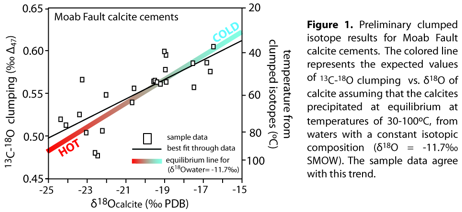AmericanChemicalSociety.com
Reports: DNI2 49704-DNI2: The Use of Carbonate 'Clumped Isotope' Thermometry to Quantify Temperatures of Burial and Diagenesis from 0-200C
Katharine W. Huntington, PhD, University of Washington
Quantifying the temperature conditions under which diagenesis
and fluid flow modulate hydrocarbon maturation, porosity, and permeability is
important for predicting hydrocarbon formation and preservation in tectonically
active basins. Clumped isotope thermometry determines the
precipitation temperature of carbonate minerals based on the abundance of 13C-18O
bonds in the carbonate crystal lattice, potentially enabling the thermal
conditions of fracturing, fluid flow, and growth of diagenetic
minerals in hydrocarbon reservoirs to be determined independent of the
composition of co-existing fluids, pressure, or time. A single 13C-18O
clumping measurement provides independent estimates of the growth temperature
and ![]()
![]()
The Paradox Basin, an intraforeland flexural basin in SE Utah, hosts 3 km of Pennsylvanian-Jurassic sediments that underwent burial, diagenesis and exhumation in the last 120 Myr. In Spring 2010, we sampled calcite veins developed along sections of the Lisbon Valley and Moab Faults, two major Laramide normal fault systems in the Basin. Previously published vitrinite reflectance, Rock-Eval Pyrolysis, fluid inclusion, and stable isotope data indicate that the diagenetic calcites formed during fault-parallel hydrocarbon migration at 30–125°C, from deeply circulating meteoric waters with little variation in O-isotopic composition (Eichhubl et al., 2009; Chan et al., 2000; Garden, 2001; Davatzes et al., 2005). Preliminary clumped isotope results and our ongoing work on outcrop and core samples serve to test this model.
Clumped isotope analyses of
26 samples of calcite veins from the footwall of the Moab fault performed at
Caltech in September 2010 indicate a wide range of
![]()
![]()
![]()
![]()
![]()
![]()
![]()
![]()
Future work on this aspect of
the project will involve careful documentation of cross-cutting relationships
in outcrop and thin section, additional clumped isotope measurements, CL
microscopy, and micro-sampling of the cements for
![]()
Following
the recommendations of the reviewers of the original PRF proposal, in parallel
with our work in the Paradox Basin, additional petrographic
(including CL) observations of diagenetic calcites in
Eocene limestones from the Colorado Plateau were
conducted to complete the pilot study that motivated this PRF project. This
work provided a test of the methodology to be used in the Paradox Basin case
study, in particular highlighting the need to interpret clumped isotope results
in the context of careful textural analysis and CL because samples can
integrate multiple diagenetic phases. Results are
detailed in a manuscript by Huntington, Budd, Wernicke,
and Eiler to be submitted to the Journal of Sedimentary Research in October 2010, and the major
conclusions of this work are as follows: Conventional
![]()
![]()
Motivated by these findings, we analyzed thin sections of the Paradox basin samples petrographically, and initiated CL-SEM work summer 2010 at the University of Puget Sound. The CL and petrographic analysis will be completed at CU Boulder in collaboration with Prof. David Budd, an unfunded collaborator in November 2010.
In addition to natural case studies, we proposed to improve the precision of clumped isotope thermometry by analyzing synthetic calcite grown at known temperatures between 50-200°C. Since submission of the proposal, Guo et al. (2009) published theoretical calibrations for several carbonate minerals including calcite based on transition state theory and statistical thermodynamics, and Dennis and Schrag (2010) corroborated the prediction for calcite up to 60°C. Our apparatus for calcite precipitations <100°C is operational, and precipitation experiments >100°C are planned at UT Austin (collaboration with Jim Gardner).
In summary, encouraging results from the Paradox Basin and Colorado Plateau demonstrate the utility of clumped isotopes for determining fluid migration temperatures and isotopic compositions in the crust during deformation and thermal perturbation. Upon completion, this work will serve as a model for combining clumped isotope thermometry with isotopes, other temperature proxies, petrography, and structural geology of basins to constrain the thermal and chemical history of fluids in tectonically active reservoirs.
Copyright © American Chemical Society




